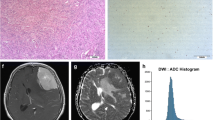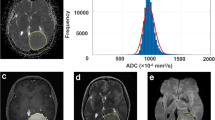Abstract
Background
Medulloblastomas are the most common central nervous system tumors in childhood. Treatment and prognosis strongly depend on histology and transcriptomic profiling. However, the proliferative potential also has prognostical value. Our study aimed to investigate correlations between histogram profiling of diffusion-weighted images and further microarchitectural features.
Material and methods
Seven patients (age median 14.6 years, minimum 2 years, maximum 20 years; 5 male, 2 female) were included in this retrospective study. Using a Matlab-based analysis tool, histogram analysis of whole apparent diffusion coefficient (ADC) volumes was performed.
Results
ADC entropy revealed a strong inverse correlation with the expression of the proliferation marker Ki67 (r = − 0.962, p = 0.009) and with total nuclear area (r = − 0.888, p = 0.044). Furthermore, ADC percentiles, most of all ADCp90, showed significant correlations with Ki67 expression (r = 0.902, p = 0.036).
Discussion and conclusion
Diffusion histogram profiling of medulloblastomas provides valuable in vivo information which potentially can be used for risk stratification and prognostication. First of all, entropy revealed to be the most promising imaging biomarker. However, further studies are warranted.


Similar content being viewed by others
References
Taylor MD, Northcott PA, Korshunov A, Remke M, Cho YJ, Clifford SC, Eberhart CG, Parsons DW, Rutkowski S, Gajjar A, Ellison DW, Lichter P, Gilbertson RJ, Pomeroy SL, Kool M, Pfister SM (2011) Molecular subgroups of medulloblastoma: the current consensus. Acta Neuropathol 123:465–472. https://doi.org/10.1007/s00401-011-0922-z
Massimino M, Biassoni V, Gandola L, Garrè ML, Gatta G, Giangaspero F, Poggi G, Rutkowski S (2016) Childhood medulloblastoma. Crit Rev Oncol Hematol 1–17:35–51. https://doi.org/10.1016/j.critrevonc.2016.05.012
Massimino M, Antonelli M, Gandola L, Miceli R, Pollo B, Biassoni V, Schiavello E, Buttarelli FR, Spreafico F, Collini P, Giangaspero F (2012) Histological variants of medulloblastoma are the most powerful clinical prognostic indicators. Pediatr Blood Cancer 60:210–216. https://doi.org/10.1002/pbc.24225
Patay Z, DeSain LA, Hwang SN et al (2015) MR imaging characteristics of wingless-type-subgroup pediatric medulloblastoma. Am J Neuroradiol 36:2386–2393. https://doi.org/10.3174/ajnr.A4495
Perreault S, Ramaswamy V, Achrol AS, Chao K, Liu TT, Shih D, Remke M, Schubert S, Bouffet E, Fisher PG, Partap S, Vogel H, Taylor MD, Cho YJ, Yeom KW (2014) MRI surrogates for molecular subgroups of medulloblastoma. AJNR Am J Neuroradiol 35:1263–1269. https://doi.org/10.3174/ajnr.A3990
Yeom KW, Mobley BC, Lober RM, Andre JB, Partap S, Vogel H, Barnes PD (2013) Distinctive MRI features of pediatric medulloblastoma subtypes. Am J Roentgenol 200:895–903. https://doi.org/10.2214/AJR.12.9249
Łastowska M, Jurkiewicz E, Trubicka J, Daszkiewicz P, Drogosiewicz M, Malczyk K, Grajkowska W, Matyja E, Cukrowska B, Pronicki M, Perek-Polnik M, Perek D, Dembowska-Bagińska B (2015) Contrast enhancement pattern predicts poor survival for patients with non-WNT/SHH medulloblastoma tumours. J Neuro-Oncol 123:1–9. https://doi.org/10.1007/s11060-015-1779-0
Gihr GA, Horvath-Rizea D, Garnov N, Kohlhof-Meinecke P, Ganslandt O, Henkes H, Meyer HJ, Hoffmann KT, Surov A, Schob S (2018) Diffusion profiling via a histogram approach distinguishes low-grade from high-grade meningiomas, can reflect the respective proliferative potential and progesterone receptor status. Mol Imaging Biol. https://doi.org/10.1007/s11307-018-1166-2
Horvath-Rizea D, Surov A, Hoffmann K-T, Garnov N, Vörkel C, Kohlhof-Meinecke P, Ganslandt O, Bäzner H, Gihr GA, Kalman M, Henkes E, Henkes H, Schob S (2018) The value of whole lesion ADC histogram profiling to differentiate between morphologically indistinguishable ring enhancing lesions—comparison of glioblastomas and brain abscesses. Oncotarget 9:18148–18159. https://doi.org/10.18632/oncotarget.24454
Schob S, Surov A, Wienke A, Meyer HJ, Spielmann RP, Fiedler E (2017) Correlation between aquaporin 4 expression and different DWI parameters in grade I meningioma. Mol Imaging Biol 19:138–142. https://doi.org/10.1007/s11307-016-0978-1
Schob S, Meyer H, Dieckow J, Pervinder B, Pazaitis N, Höhn A, Garnov N, Horvath-Rizea D, Hoffmann KT, Surov A (2017) Histogram analysis of diffusion weighted imaging at 3T is useful for prediction of lymphatic metastatic spread, proliferative activity, and cellularity in thyroid cancer. IJMS 18:821–812. https://doi.org/10.3390/ijms18040821
Schob S, Meyer J, Gawlitza M, Frydrychowicz C, Müller W, Preuss M, Bure L, Quäschling U, Hoffmann KT, Surov A (2016) Diffusion-weighted MRI reflects proliferative activity in primary CNS lymphoma. PLoS One 11:e0161386. https://doi.org/10.1371/journal.pone.0161386
Schob S, Voigt P, Bure L, Meyer HJ, Wickenhauser C, Behrmann C, Höhn A, Kachel P, Dralle H, Hoffmann KT, Surov A (2016) Diffusion-weighted imaging using a readout-segmented, multishot EPI sequence at 3 T distinguishes between morphologically differentiated and undifferentiated subtypes of thyroid carcinoma—a preliminary study. TRANON 9:403–410. https://doi.org/10.1016/j.tranon.2016.09.001
Koral K, Mathis D, Gimi B, Gargan L, Weprin B, Bowers DC, Margraf L (2013) Common pediatric cerebellar tumors: correlation between cell densities and apparent diffusion coefficient metrics. Radiology 268:532–537. https://doi.org/10.1148/radiol.13121362
Yamashita Y, Kumabe T, Higano S, Watanabe M, Tominaga T (2009) Minimum apparent diffusion coefficient is significantly correlated with cellularity in medulloblastomas. Neurol Res 31:940–946. https://doi.org/10.1179/174313209X382520
Schob S, Meyer HJ, Pazaitis N, Schramm D, Bremicker K, Exner M, Höhn AK, Garnov N, Surov A (2017) ADC histogram analysis of cervical cancer aids detecting lymphatic metastases—a preliminary study. Mol Imaging Biol 61:69. https://doi.org/10.1007/s11307-017-1073-y
Schob S, Frydrychowicz C, Gawlitza M, Bure L, Preuß M, Hoffmann KT, Surov A (2016) Signal intensities in preoperative MRI do not reflect proliferative activity in meningioma. Transl Oncol 9:274–279. https://doi.org/10.1016/j.tranon.2016.05.003
Surov A, Ginat DT, Sanverdi E, Lim CCT, Hakyemez B, Yogi A, Cabada T, Wienke A (2016) Use of diffusion weighted imaging in differentiating between malignant and benign meningiomas. A multicenter analysis. WNEU 88:598–602. https://doi.org/10.1016/j.wneu.2015.10.049
Just N (2014) Improving tumour heterogeneity MRI assessment with histograms. Br J Cancer 111:2205–2213. https://doi.org/10.1038/bjc.2014.512
Chen L, Liu M, Bao J, Xia Y, Zhang J, Zhang L, Huang X, Wang J (2013) The correlation between apparent diffusion coefficient and tumor cellularity in patients: a meta-analysis. PLoS One 8:e79008. https://doi.org/10.1371/journal.pone.0079008.s001
Surov A, Meyer HJ, Wienke A (2017) Correlation between apparent diffusion coefficient (ADC) and cellularity is different in several tumors: a meta-analysis. Oncotarget 8:59492–59499. https://doi.org/10.18632/oncotarget.17752
Schob S, Surov A, Wienke A, Meyer HJ, Spielmann RP, Fiedler E (2016) Correlation between aquaporin 4 expression and different DWI parameters in grade I meningioma. Mol Imaging Biol 19:138–142. https://doi.org/10.1007/s11307-016-0978-1
Pollo B, Mazzetti S, Patane M, Calatozzolo C, di Meco F, Silvani A (2014) ME-16 * Is aquaporin4 (AQP4) involved in adult human medulloblastoma dissemination or in a beneficial barrier formation? Neuro-Oncology 16:v123–v123. https://doi.org/10.1093/neuonc/nou261.15
Cambruzzi E (2018) Medulloblastoma, WNT-activated/SHH-activated: clinical impact of molecular analysis and histogenetic evaluation. Childs Nerv Syst 34:809–815. https://doi.org/10.1007/s00381-018-3765-2
Author information
Authors and Affiliations
Corresponding author
Ethics declarations
Conflict of interest
The authors declare no conflict of interest.
Rights and permissions
About this article
Cite this article
Schob, S., Beeskow, A., Dieckow, J. et al. Diffusion profiling of tumor volumes using a histogram approach can predict proliferation and further microarchitectural features in medulloblastoma. Childs Nerv Syst 34, 1651–1656 (2018). https://doi.org/10.1007/s00381-018-3846-2
Received:
Accepted:
Published:
Issue Date:
DOI: https://doi.org/10.1007/s00381-018-3846-2




